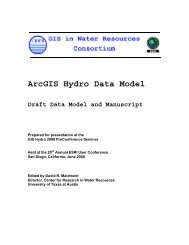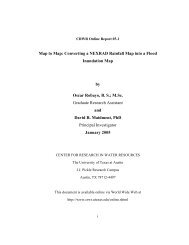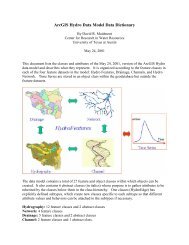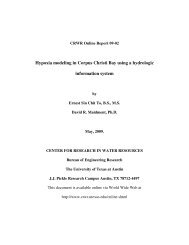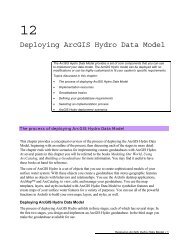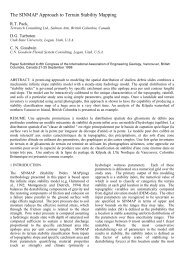View the Whole Report - Center for Research in Water Resources ...
View the Whole Report - Center for Research in Water Resources ...
View the Whole Report - Center for Research in Water Resources ...
Create successful ePaper yourself
Turn your PDF publications into a flip-book with our unique Google optimized e-Paper software.
fabrics that were run without a major ra<strong>in</strong>fall event occurr<strong>in</strong>g <strong>in</strong> <strong>the</strong> <strong>in</strong>terval all show this<br />
behavior.<br />
It is noteworthy that after major ra<strong>in</strong>fall events, detention times decreased <strong>for</strong> <strong>the</strong><br />
woven fabrics. This observation suggests that sediment accumulated <strong>in</strong> <strong>the</strong> woven silt<br />
fence fabrics could have been washed off result<strong>in</strong>g <strong>in</strong> <strong>in</strong>creased flow rates. The woven<br />
Belton fabric exhibited detention times on May 4 and June 7th quite similar to <strong>the</strong> <strong>in</strong>itial<br />
detention time observed on April 11. This wash<strong>in</strong>g of <strong>the</strong> fabric may also occur <strong>in</strong> <strong>the</strong><br />
field when ra<strong>in</strong>fall precedes <strong>the</strong> pond<strong>in</strong>g of runoff. Ra<strong>in</strong>fall did not appear to have an<br />
effect on <strong>the</strong> non-woven fabric (August 8). Non-woven fabrics appear to have reta<strong>in</strong>ed<br />
more of <strong>the</strong> trapped sediment <strong>in</strong> <strong>the</strong> three-dimensional structure and, <strong>the</strong>re<strong>for</strong>e, <strong>the</strong><br />
wash<strong>in</strong>g of <strong>the</strong> fabric by <strong>the</strong> ra<strong>in</strong>fall does not occur.<br />
The non-woven fabric had <strong>the</strong> highest reported manufacturers permittivity, which<br />
<strong>in</strong>dicates short detention times, but this fabric had <strong>the</strong> longest measured detention times<br />
of all <strong>the</strong> controls tested. Clogg<strong>in</strong>g was more of a factor <strong>in</strong> <strong>the</strong> non-woven because of <strong>the</strong><br />
three dimensional construction of <strong>the</strong> fabric. Woven fabrics have a more twodimensional<br />
profile and are prone to clogg<strong>in</strong>g, but to a lesser extent than non-woven<br />
fabrics.<br />
5.2 Permeameter Tests<br />
Samples of silt fence fabric were subjected to constant head permeability tests<br />
because of <strong>the</strong> extremely low flow rates observed <strong>in</strong> <strong>the</strong> flume tests. Permeameter tests<br />
permitted a greater <strong>in</strong>sight <strong>in</strong>to <strong>the</strong> hydraulic behavior of silt fence fabrics than <strong>the</strong> flume<br />
tests. The relationship between head and flow rates was more apparent because constant<br />
heads were used and a wider range of heads were possible.<br />
5.2.1 Methodology<br />
Three samples were chosen from <strong>the</strong> fabrics tested <strong>in</strong> <strong>the</strong> flume. A modified soil<br />
permeameter allowed <strong>the</strong> flow rates to be determ<strong>in</strong>ed <strong>for</strong> heads of 0.05, 0.1, 0.2, 0.3, 0.4,<br />
0.5, and 0.6 m. ASTM D 4491 (1992) is run at a head of 0.05 m. Silt fences <strong>in</strong> <strong>the</strong> field<br />
could experience heads of up to 0.6 m.<br />
48




